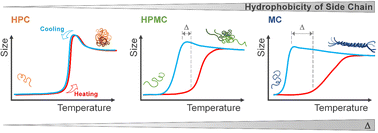Hysteresis in the thermally induced phase transition of cellulose ethers†
Abstract
Functionalized cellulosics have shown promise as naturally derived thermoresponsive gelling agents. However, the dynamics of thermally induced phase transitions of these polymers at the lower critical solution temperature (LCST) are not fully understood. Here, with experiments and theoretical considerations, we address how molecular architecture dictates the mechanisms and dynamics of phase transitions for cellulose ethers. Above the LCST, we show that hydroxypropyl substituents favor the spontaneous formation of liquid droplets, whereas methyl substituents induce fibril formation through diffusive growth. In celluloses which contain both methyl and hydroxypropyl substituents, fibrillation initiates after liquid droplet formation, suppressing the fibril growth to a sub-diffusive rate. Unlike for liquid droplets, the dissolution of fibrils back into the solvated state occurs with significant thermal hysteresis. We tune this hysteresis by altering the content of substituted hydroxypropyl moieties. This work provides a systematic study to decouple competing mechanisms during the phase transition of multi-functionalized macromolecules.



 Please wait while we load your content...
Please wait while we load your content...